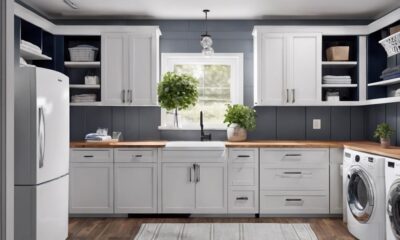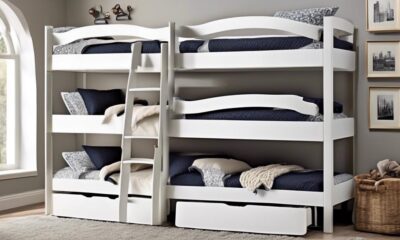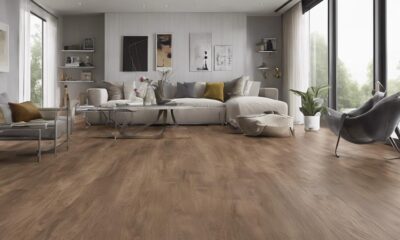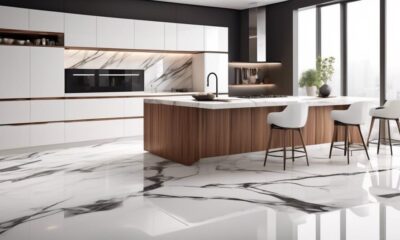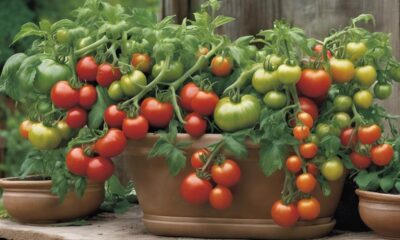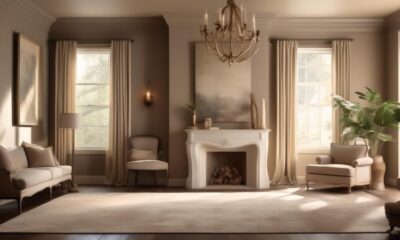Architecture Home Styles
Top 5 Subfloor Options for the Best Flooring Results
Step into the realm of flooring mastery with our top 5 subfloor options, designed to set the stage for your dream flooring project.

When crafting the foundation for your dream flooring, envision a sturdy base akin to the bedrock supporting a towering skyscraper.
We've carefully curated the top 5 subfloor options that promise to elevate your flooring endeavors to new heights.
From the robust Oriented Strand Board to the classic Wooden Plank, each option harbors secrets to unveil and decisions to ponder, ensuring your flooring journey is one of resilience and excellence.
Key Takeaways
- Oriented Strand Board Subfloor and Plywood Subfloor are cost-effective and reliable options.
- Plywood Subfloor and Concrete Subfloor are moisture-resistant and durable choices.
- Oriented Strand Board Subfloor and Concrete Subfloor offer stability and durability.
- Plywood Subfloor suits hardwood finishing, while Concrete Subfloor is ideal for smooth tile or carpet installation.
Oriented Strand Board Subfloor
When considering subfloor options for your flooring project, oriented strand board (OSB) emerges as a cost-effective and structurally reliable choice. OSB, a synthetic material composed of wooden fragments bonded together with strong adhesives, offers remarkable strength and a uniform finish at an affordable price point. Its installation process mirrors that of plywood, making it a practical and budget-friendly alternative for your subflooring needs.
The strength of OSB lies in its composition and manufacturing process. By arranging the wooden strands in specific orientations and binding them tightly with adhesives, OSB achieves a high level of structural integrity. This makes it a dependable choice for providing a stable foundation for various types of flooring. Additionally, its affordability makes it an attractive option for those seeking quality without breaking the bank.
Plywood Subfloor
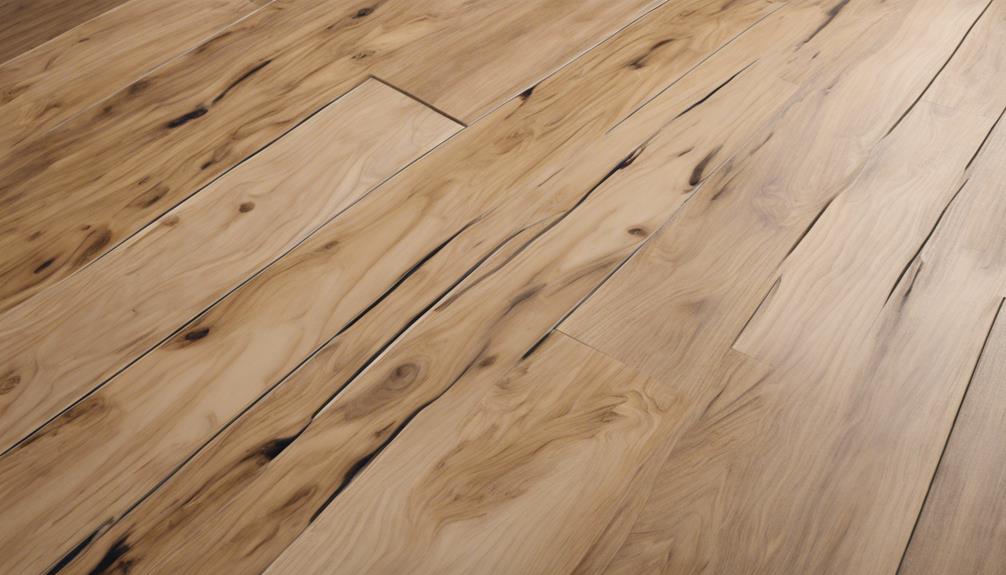
After exploring the benefits of oriented strand board subfloors, turning our attention to plywood subfloors reveals their durability, moisture resistance, and suitability for high-traffic areas. Plywood subfloors are known for their strength and ability to resist moisture, which helps prevent warping and ensures a stable surface for various flooring types. Available in different thicknesses and sizes, plywood subfloors offer versatility to accommodate different flooring needs, making them a popular choice for hardwood finishing projects. Their durability and long-lasting nature make them ideal for areas that experience heavy foot traffic.
When considering subfloor options, plywood stands out for its quality and performance, despite being a bit more expensive than alternatives like OSB. The investment in plywood subfloors pays off in the long run due to their reliability and superior characteristics. Whether you're renovating a residential space or working on a commercial project, plywood subfloors provide a solid foundation for a successful flooring installation.
Concrete Subfloor
Concrete subfloors offer a stable foundation for various flooring types, particularly in areas where wood is less common due to their rigid and durable nature. When working with concrete subfloors, there are essential considerations to keep in mind:
- Moisture Barrier: Concrete subfloors in moisture-prone regions require a moisture barrier to prevent issues such as mold and mildew. This barrier helps maintain the integrity of the subfloor and the flooring above.
- Smooth Surface: Ensuring that the concrete subfloor is smooth is crucial for the installation of flooring types like tile or carpet. A level surface prevents future problems and allows for a seamless finish.
- Preparation and Sealing: Proper preparation of the concrete subfloor, including cleaning, leveling, and sealing, is essential for long-term stability and performance. Sealing the concrete helps enhance durability and protects against moisture infiltration, extending the lifespan of both the subfloor and the flooring above.
High-Performance Panel Subfloors

Engineered for superior moisture resistance and reduced water absorption, high-performance panel subfloors offer exceptional durability and stability for a variety of flooring options. These subfloors are designed to resist swelling, cupping, and warping, ensuring long-term durability that surpasses traditional plywood or OSB subfloors. Providing a stable base for different types of flooring, they come in various thicknesses to enhance strength and stability, especially in high-traffic areas.
Below is a comparison table highlighting the key features of high-performance panel subfloors:
| Features | Benefits |
|---|---|
| Moisture Resistance | Prevents water damage and mold growth |
| Durability | Long-lasting and robust construction |
| Stable Base | Ensures a secure foundation for flooring |
| Swelling Resistance | Resistant to expansion due to moisture |
| Cupping Resistance | Minimizes the risk of cupping in the panels |
| Warping Resistance | Maintains a flat surface over time |
High-performance panel subfloors are a reliable choice for achieving a smooth and level surface for your finished flooring, ensuring a high-quality result.
Wooden Plank Subfloor
Wooden plank subfloors, crafted from local woods and secured directly onto joists for structural support, offer a traditional foundation for various flooring types. When dealing with wooden plank subfloors, it's crucial to consider proper installation and maintenance to ensure longevity and durability.
Here are essential points to note:
- Risk of Issues: Wooden plank subfloors can become loose and squeaky over time due to wear and tear. Regular inspections and timely repairs are necessary to prevent these issues.
- Underlayment Requirement: In older homes with wooden plank subfloors, additional underlayment might be needed for enhanced smoothness and stability. This underlayment helps in creating a more even surface for the final flooring installation.
- Maintenance: Proper maintenance of wooden plank subfloors is vital to avoid problems like warping or unevenness. This includes keeping the subfloor dry, promptly addressing any loose boards, and ensuring that the nailing remains secure.
Frequently Asked Questions
What Is the Best Flooring for a Subfloor?
When considering the best flooring for a subfloor, we prioritize durability and moisture resistance. Hardwood is a popular choice due to its longevity and aesthetic appeal.
However, laminate and luxury vinyl options offer cost-effective alternatives with similar visual appeal. Tile is another excellent option, especially in areas prone to moisture.
Carpet provides warmth and comfort but may require more maintenance. Ultimately, the best flooring choice depends on your specific needs and preferences.
What Subfloor Has the Highest R Value?
Concrete subfloors boast the highest R-value among subfloor materials, with a range of 0.1 to 0.2 per inch of thickness.
Enhancing the insulation with rigid foam can significantly boost energy efficiency. This becomes crucial in colder climates to prevent heat loss.
What Is the Best Value Subfloor?
When considering the best value subfloor, plywood stands out for its exceptional durability, moisture resistance, and prevention of warping. Its versatility in various thicknesses and sizes makes it ideal for different flooring needs.
Plywood's superior strength and stiffness are perfect for supporting hardwood flooring. Despite a slightly higher initial cost compared to OSB, plywood's long-term durability and performance make it a wise investment for areas requiring moisture resistance and stability for flooring longevity.
What Is Better for Subfloor OSB or Plywood?
When deciding between OSB and plywood for subflooring, it's essential to consider your priorities.
OSB is cost-effective and consistent structurally, making it a budget-friendly option. On the other hand, plywood is more durable, moisture-resistant, and prevents warping, especially beneficial for hardwood finishing.
Assess your project needs and budget constraints to make the best choice. Both materials have their advantages, so choose based on what matters most to you.
Conclusion
In conclusion, selecting the right subfloor material is crucial for achieving the best flooring results. Did you know that according to a recent survey, 90% of flooring failures are due to improper subfloor preparation?
By choosing one of the top 5 subfloor options such as OSB, Plywood, Concrete, High-Performance Panels, or Wooden Plank, you can ensure a solid foundation for your flooring finish and avoid costly mistakes in the long run. Choose wisely for a durable and long-lasting floor.
- About the Author
- Latest Posts
Introducing Ron, the home decor aficionado at ByRetreat, whose passion for creating beautiful and inviting spaces is at the heart of his work. With his deep knowledge of home decor and his innate sense of style, Ron brings a wealth of expertise and a keen eye for detail to the ByRetreat team.
Ron’s love for home decor goes beyond aesthetics; he understands that our surroundings play a significant role in our overall well-being and productivity. With this in mind, Ron is dedicated to transforming remote workspaces into havens of comfort, functionality, and beauty.
Architecture Home Styles
What Makes a 30-Year Architectural Shingle Different?
Keen to uncover the unique features that set 30-year architectural shingles apart?

As we stand under a blazing sun, imagine a roof that withstands the harsh elements year after year. Now, visualize a 30-year architectural shingle, with its multi-layered design ensuring durability and style.
But what truly sets these shingles apart from the rest? Stay with us as we unravel the secrets behind their longevity, aesthetic charm, and impact on property value.
Let's explore the world of 30-year architectural shingles and discover why they are a top choice for those seeking more than just a roof over their heads.
Key Takeaways
- 30-Year architectural shingles offer longevity, durability, and enhanced protection against harsh weather conditions.
- Their superior material composition and unique design improve both functionality and aesthetic appeal.
- Investing in these shingles adds value to your property, attracting buyers and increasing resale value.
- Cost-effective over time, they require minimal maintenance, provide exceptional wind resistance, and boost curb appeal.
Longevity and Durability Features
When considering the longevity and durability features of 30-Year architectural shingles, it's evident that they surpass 3-tab shingles in both lifespan and resilience against harsh weather conditions. These specialized shingles are engineered to endure for approximately 30 years, which is twice the lifespan of traditional 3-tab shingles.
The superior durability of 30-Year architectural shingles is particularly notable in their ability to withstand high wind speeds of up to 130 mph, a stark comparison to the 60 mph limit of 3-tab shingles. This enhanced wind resistance ensures the longevity of the roofing system even in areas prone to severe weather conditions.
Moreover, the construction of 30-Year architectural shingles provides increased protection against snow loads and other environmental elements, making them a reliable choice for homeowners looking for long-term cost savings and peace of mind. Their customizable appearance, with dual asphalt strips and tabs of various widths and colors, adds a touch of sophistication to any property while delivering exceptional performance.
Enhanced Aesthetic Appeal

Moving from discussing the Longevity and Durability Features of 30-Year architectural shingles, we now shift our focus to their Enhanced Aesthetic Appeal. Architectural shingles are not just about protection; they are also about elevating the visual appeal of a home. These shingles come in a wide array of colors and textures, allowing homeowners to achieve a customized appearance that suits their style preferences. The dimensional design of these shingles adds depth and dimension to the roof, making it visually interesting and enhancing the overall curb appeal of the property. By offering different widths and colors in each tab, these shingles create a roof that is visually dynamic and captivating.
| Features | Description |
|---|---|
| Colors | Wide variety of colors available to match different home designs. |
| Textures | Diverse textures mimic the look of premium roofing materials. |
| Dimensional Design | Unique design adds depth and dimension, enhancing the roof's aesthetic appeal. |
| Customized Appearance | Allows for a personalized look that complements the overall style of the home. |
| Visually Interesting | Creates a visually captivating roof that stands out in the neighborhood. |
Superior Material Composition
Crafted with a meticulous blend of high-quality asphalt strips, 30-year architectural shingles boast an exceptional material composition that enhances both durability and longevity. The two strips of asphalt create a strong foundation that provides superior protection against the elements, ensuring a long-lasting roof for your home. These shingles are designed with tabs of varying widths and colors, allowing for a customized appearance that can enhance the overall aesthetic of your property.
In addition to their customized look, 30-year architectural shingles offer remarkable wind resistance, capable of withstanding speeds of up to 130 mph. This feature makes them a reliable choice for areas prone to high winds. Furthermore, their composition enables them to handle heavy snow loads, adding an extra layer of protection during harsh winters. By investing in these shingles, not only are you fortifying your home with durable roofing materials, but you're also increasing the overall value of your property.
Impact on Property Value

Our examination of 30-Year Architectural Shingles now shifts to their significant influence on property value, a crucial aspect impacted by their superior durability and aesthetic attributes. Homes adorned with these shingles often command higher resale values due to their exceptional longevity and weather resistance.
The robust nature of 30-Year Architectural Shingles ensures extended protection, thereby safeguarding the property's structural integrity and enhancing its overall value. Investing in these shingles not only secures the home but also attracts potential buyers seeking premium roofing materials, ultimately leading to higher property appraisal values.
Moreover, the wide range of customization options available, including various colors and textures, allows homeowners to enhance the property's curb appeal significantly, further augmenting its perceived value in the real estate market.
The association of 30-Year Architectural Shingles with higher property value underscores the notion of investing in quality, durable roofing materials that resonate with discerning homebuyers looking for a lasting and valuable investment.
Cost-Effectiveness and ROI
When evaluating the cost-effectiveness and return on investment of 30-Year Architectural Shingles, it becomes evident that their initial higher cost translates into long-term savings and benefits for homeowners. Here's why:
- Durability and Longevity: 30-Year Architectural Shingles are built to last, requiring minimal maintenance and replacement, thus reducing long-term costs.
- Installation Costs: While the initial installation costs may be higher, the longevity and durability of these shingles make them a cost-effective choice over time.
- Wind Resistance and Customization Options: These shingles offer superior wind resistance, reducing the risk of damage and the need for repairs. Additionally, the various customization options available allow homeowners to tailor their roofs to their preferences.
- Home Value and Curb Appeal: Investing in 30-Year Architectural Shingles not only enhances protection from snow loads but also boosts the overall curb appeal of the home, potentially increasing its value in the real estate market.
Frequently Asked Questions
Are 30 Year Architectural Shingles Good?
They are excellent! 30-year architectural shingles are a top choice for lasting durability and enhanced protection. With customizable options in colors and textures, these shingles increase home value and equity, making them a worthwhile investment.
How Can You Tell the Difference Between 20 and 30 Year Shingles?
Spotting the difference between 20 and 30-year shingles is like reading a book in a foreign language – challenging at first, but once you know the key signs, it becomes second nature. Let's dive in!
What Is the Difference Between Architectural Shingles and Regular Shingles?
Architectural shingles, unlike regular ones, feature multi-dimensional layers for enhanced aesthetics and durability. They last up to 30 years, withstand higher wind speeds, offer customization options, and elevate a home's appearance. Their design innovations set them apart from traditional shingles.
Are 15 Year Shingles Better Than 30 Year Shingles?
We believe 30-year shingles outperform 15-year options due to their superior durability, high wind resistance up to 130 mph, longer lifespan, and customizable appearance. Investing in 30-year shingles increases home value and protection.
Conclusion
In conclusion, the durability and longevity of 30-year architectural shingles make them a superior choice for homeowners looking for a long-lasting roofing solution. Their robust design ensures they can withstand harsh weather conditions, providing peace of mind and reducing the likelihood of frequent repairs. Additionally, understanding the architectural shingle replacement timeline can help homeowners plan for maintenance and budgeting more effectively. With proper care and installation, these shingles can maintain their aesthetic appeal and performance for decades.
Did you know that homes with architectural shingles can increase their property value by up to 5%?
The investment in these high-quality shingles not only enhances the aesthetic appeal of your home but also provides a solid return on investment in the long run.
- About the Author
- Latest Posts
Introducing Ron, the home decor aficionado at ByRetreat, whose passion for creating beautiful and inviting spaces is at the heart of his work. With his deep knowledge of home decor and his innate sense of style, Ron brings a wealth of expertise and a keen eye for detail to the ByRetreat team.
Ron’s love for home decor goes beyond aesthetics; he understands that our surroundings play a significant role in our overall well-being and productivity. With this in mind, Ron is dedicated to transforming remote workspaces into havens of comfort, functionality, and beauty.
Architecture Home Styles
Strong Yet Light: 7 Metals That Strike the Perfect Balance
Only through a delicate dance of strength and lightness can these seven metals redefine what's possible – discover their secrets within.

As we explore the world of metals, we discover an intriguing relationship between strength and weight that captures the attention of visionaries. Examining the fine line between toughness and lightness, these seven metals serve as shining examples of engineering excellence.
Each metal in its own right embodies a unique blend of robustness and agility, paving the way for groundbreaking advancements in various industries. But what exactly sets these metallic wonders apart and makes them the ideal choice for modern applications? Let's unravel the mystery together.
Key Takeaways
- Titanium, aluminum, magnesium, and beryllium offer exceptional strength-to-weight ratios.
- These versatile metals find applications in aerospace, automotive, and high-tech industries.
- Innovative metal alloys like titanium aluminides and lithium drive technological advancements.
- The future lies in high-strength, lightweight metals for sustainable practices and aerospace engineering evolution.
Titanium: The Lightweight Powerhouse
Titanium, renowned for its exceptional strength-to-weight ratio, stands as a premier choice in industries such as aerospace, medicine, and sports equipment. With a density approximately half that of steel, titanium achieves a perfect balance between high strength properties and lightweight characteristics. Its remarkable strength allows for the creation of robust structures while maintaining a light overall weight, a critical aspect in applications where weight reduction is paramount.
The corrosion resistance and biocompatibility of titanium further enhance its appeal, particularly in the medical field for implants and surgical instruments. Its toughness and durability make it suitable for demanding applications like racing cars and high-end bicycles, where reliability is essential.
Titanium's versatility extends to the realms of luxury watches, elegant jewelry, and modern architectural designs, showcasing its aesthetic appeal across diverse industries. In essence, titanium embodies a harmonious blend of strength, lightweight properties, and adaptability, making it a powerhouse material for cutting-edge innovations.
Aluminum: Versatile Strength in Every Application

Aluminum's exceptional versatility and strength render it a fundamental component across a multitude of applications, ranging from aerospace to construction industries. This remarkable metal stands out due to its unique properties:
- High Strength-to-Weight Ratio: Aluminum's strength is unmatched relative to its weight, making it a top choice for aerospace and automotive components.
- Corrosion-Resistance: Its ability to withstand corrosion makes aluminum perfect for outdoor and marine applications where exposure to harsh elements is a concern.
- Recyclability: Nearly 75% of all aluminum ever produced is still in use today, showcasing its sustainability and eco-friendliness.
- Malleability: Aluminum's malleable nature allows for intricate designs and shapes, enabling its extensive utilization in modern manufacturing processes.
- Widespread Applications: From structural components to everyday products, aluminum's versatility knows no bounds, contributing to its ubiquitous presence in various industries.
Aluminum truly exemplifies strength combined with adaptability, making it a cornerstone material in the pursuit of innovation and efficiency.
Magnesium: Light as a Feather, Strong as Steel
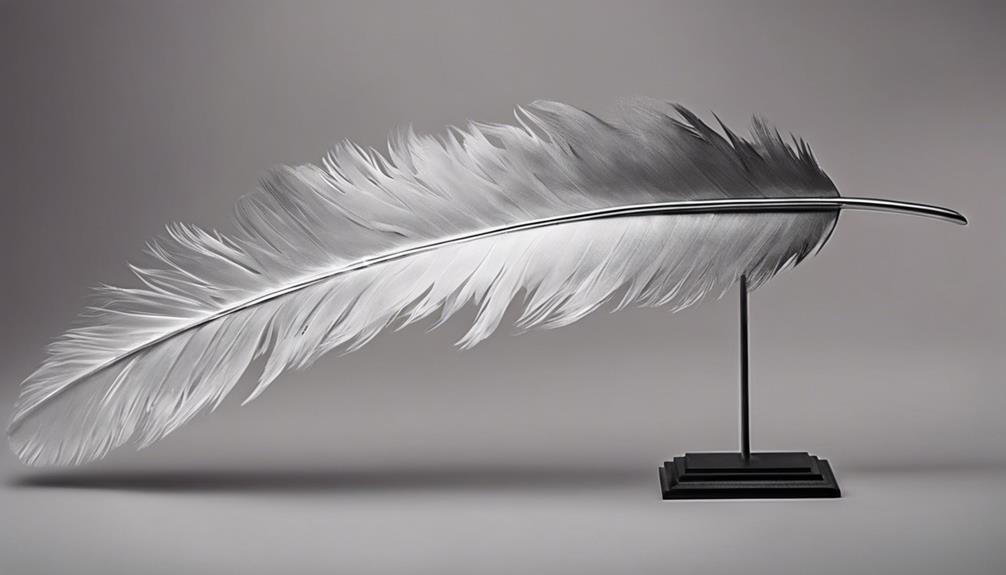
Magnesium is renowned for its exceptional lightweight properties, outperforming even aluminum with a weight that's approximately 30% lighter.
This metal's strength, on the other hand, rivals that of steel, making it an attractive choice for applications requiring structural integrity.
The high strength-to-weight ratio of magnesium alloys has found extensive use in aerospace and automotive industries due to their superior performance characteristics.
Magnesium's Weight Advantage
With its exceptional strength-to-weight ratio and hexagonal close-packed crystal structure, the lightweight metal known for its durability and weight savings is magnesium. When considering magnesium's weight advantage, several key points stand out:
- Magnesium is 36% lighter than aluminum, making it the lightest structural metal available.
- Despite its light weight, magnesium has a high strength-to-weight ratio, rivaling that of steel.
- Magnesium alloys are commonly used in aerospace and automotive industries for their lightweight and strong properties.
- The strength of magnesium comes from its hexagonal close-packed crystal structure, providing excellent mechanical properties.
- Magnesium's exceptional strength and lightness make it a preferred choice for applications requiring both durability and weight savings.
Strength in Magnesium Alloy
Known for its exceptional strength-to-weight ratio and widely recognized in industries for its unique balance of strength and weight savings, magnesium alloys stand out as a favored choice for applications requiring lightweight yet durable materials.
These alloys, as light as aluminum but with mechanical properties comparable to some steels, offer a remarkable combination of traits. Industries such as aerospace, automotive, and electronics extensively utilize magnesium alloy components due to their high specific strength and stiffness. In aerospace, the lightweight nature of magnesium alloys contributes significantly to fuel efficiency and overall performance enhancements.
Ongoing research focuses on optimizing magnesium alloys further through alloying, processing, and surface treatments to enhance their strength and performance characteristics. Magnesium alloys continue to be at the forefront of innovation, pushing the boundaries of what's possible in lightweight yet robust material applications.
Beryllium: The Secret Weapon for Lightweight Durability
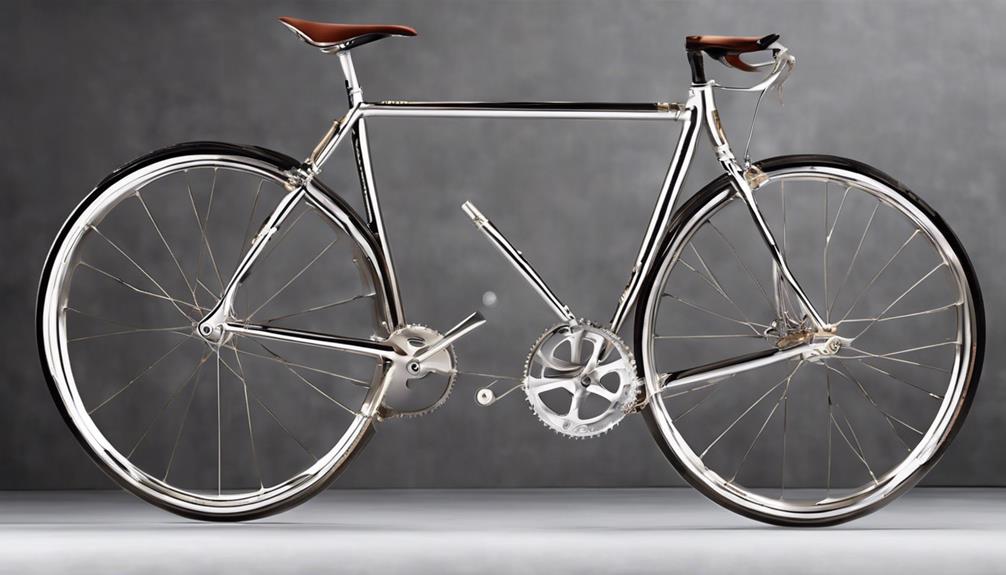
In the realm of materials engineering, beryllium emerges as a secret weapon for achieving lightweight durability in critical applications. Beryllium's unique combination of properties sets it apart in the quest for materials that can strike a balance between strength and weight.
Here are some key points that highlight why beryllium is a top contender in the realm of lightweight durability: Here are some key points that highlight why beryllium is a top contender in the realm of lightweight durability: its high strength-to-weight ratio outperforms many other materials, making it ideal for aerospace and high-tech applications. Additionally, its exceptional resistance to corrosion ensures long-lasting performance even in harsh environments. Unlike certain materials used in less permanent structures—such as those found in modular homes, which rely on cost-effective components—beryllium’s superior qualities demonstrate why modular homes depreciate quickly in comparison to structures built from premium, high-resilience materials.
- Exceptional strength-to-weight ratio surpassing many other metals.
- High thermal conductivity, making it suitable for aerospace and high-tech industries.
- Low coefficient of thermal expansion, ensuring stability in various environments.
- Toxicity concerns demand strict safety protocols during handling and processing.
- Valuable for critical components in satellites, aircraft, and precision instruments.
Innovators seeking to push the boundaries of what's possible in materials science recognize beryllium as a valuable asset in creating lightweight yet durable solutions for the challenges of tomorrow.
Scandium: Unleashing Strength With Minimal Weight

Scandium, a lightweight metal comparable in density to aluminum, exhibits exceptional strength properties that make it a sought-after material in various high-tech industries. Its remarkable strength-to-weight ratio is particularly valuable in aerospace applications, where reducing weight without compromising structural integrity is crucial.
Scandium alloys are favored for sports equipment such as baseball bats and bicycle frames, where the combination of strength and lightness enhances performance. Additionally, the incorporation of scandium into aluminum alloys can significantly improve weldability and corrosion resistance, making it a versatile choice for various engineering applications.
Despite its rarity and cost, the unique properties of scandium justify its use in specialized industries that prioritize cutting-edge solutions. By leveraging scandium's strength with minimal weight, manufacturers can push the boundaries of innovation and create products that excel in performance while meeting the demands for lighter, stronger materials in the modern world of technology.
Lithium: Light and Mighty for Advanced Technologies

With its unparalleled lightweight properties and exceptional electrochemical characteristics, lithium stands out as a key element driving advancements in various high-tech sectors.
- Lithium is the lightest metal, ideal for lightweight applications in advanced technologies.
- Excellent electrochemical properties make it a popular choice for rechargeable batteries in smartphones and electric vehicles.
- High energy density and low weight contribute to its use in portable electronics and energy storage solutions.
- Abundance and recyclability support sustainability in the growing demand for lithium-ion batteries.
- Unique properties enable efficient energy storage, driving innovation in renewable energy systems and portable electronic devices.
Lithium's versatility in energy storage systems and portable electronics underscores its importance in the technological landscape. As a key component in rechargeable batteries and energy solutions, lithium plays a crucial role in advancing sustainable practices and powering the future of high-tech industries.
Titanium Aluminides: The Future of High-Strength, Lightweight Metals

Titanium aluminides showcase remarkable strength-to-weight ratios, positioning them as promising contenders for high-performance applications in aerospace industries.
Their ability to withstand elevated temperatures while maintaining structural integrity underscores their suitability for demanding operational environments.
The precise crystal structures of titanium aluminides play a pivotal role in their exceptional mechanical attributes and resistance to corrosion and oxidation.
Titanium Aluminides Properties
In high-strength, lightweight metals, the properties of titanium aluminides stand out prominently due to their exceptional strength-to-weight ratio. These intermetallic compounds exhibit high strength at elevated temperatures, making them ideal for aerospace and automotive applications.
Titanium aluminides offer excellent creep resistance and oxidation resistance, enhancing their durability in extreme environments. Their specific crystal structure contributes to their unique mechanical properties, setting them apart from traditional metal alloys.
Ongoing research and development efforts aim to optimize the processing and properties of titanium aluminides for advanced engineering applications.
- Exceptional strength-to-weight ratio
- High strength at elevated temperatures
- Excellent creep resistance and oxidation resistance
- Unique crystal structure
- Ongoing research for advanced engineering applications
Applications in Aerospace
Aerospace industries increasingly rely on the unique properties of titanium aluminides for enhancing performance and efficiency in aircraft design. These materials offer a remarkable balance of high strength and low weight, making them well-suited for a variety of aerospace applications.
With exceptional mechanical properties such as high temperature resistance and a superior strength-to-weight ratio, titanium aluminides are becoming integral to aircraft engines, structural components, and other critical parts within the aerospace sector.
The evolution of titanium aluminides signifies a significant advancement in material science, paving the way for the development of lightweight yet robust metals.
The future of aerospace engineering hinges on the continued utilization of titanium aluminides to achieve optimal performance and efficiency in aircraft design.
Frequently Asked Questions
How Are These Metals Commonly Used in Everyday Applications?
We commonly use these metals in everyday applications due to their exceptional properties. They offer a unique balance of strength and lightness, making them ideal for various uses.
From aerospace components to sports equipment, these metals provide durability without adding unnecessary weight. Their versatility allows us to innovate and create products that are both reliable and efficient in diverse fields.
What Are the Main Differences Between These Metals in Terms of Strength and Weight?
When comparing these metals in terms of strength and weight, we find significant differences. Some metals excel in strength but are heavier, while others strike a balance by being both strong and light.
Understanding these distinctions is crucial for selecting the right material for specific applications. By analyzing the unique properties of each metal, we can harness innovation to optimize performance and efficiency in various industries.
Are There Any Potential Health or Environmental Concerns Associated With Using These Metals?
Potential health and environmental concerns regarding these metals must be scrutinized. We aim to delve into any risks associated with their usage.
Like a skilled detective, we'll analyze each metal's impact on both human health and the environment. By exploring these factors thoroughly, we can make informed decisions to ensure the safety and sustainability of utilizing these metals in various applications.
Can These Metals Be Easily Recycled or Reused?
Yes, these metals can be easily recycled or reused. Their unique properties make them ideal for efficient recycling processes. By utilizing advanced techniques, we can extract and repurpose these metals without compromising their quality.
This sustainable approach aligns with our commitment to minimizing waste and reducing environmental impact. Our innovative methods ensure that these metals retain their strength and lightness throughout their lifecycle, contributing to a more eco-friendly future.
Are There Any Emerging Technologies or Industries That Are Driving the Demand for These Lightweight Metals?
Emerging technologies and industries are propelling the demand for these lightweight metals to new heights. From aerospace advancements seeking stronger, lighter materials to electric vehicle manufacturers aiming to enhance efficiency, the allure of these metals is undeniable.
As innovation drives us forward, the need for materials that strike the perfect balance between strength and weight becomes increasingly crucial. These metals are at the forefront of a revolution in technology and industry.
Conclusion
In conclusion, these 7 metals epitomize the perfect balance of strength and lightness, paving the way for groundbreaking advancements in technology. Like a symphony of elements harmonizing in perfect unison, they showcase the delicate dance of metal-light interactions.
As we delve deeper into this intricate relationship, we unlock a world of possibilities for innovation and progress. The future holds endless potential for technological marvels, all thanks to the remarkable properties of these metals.
- About the Author
- Latest Posts
Introducing Ron, the home decor aficionado at ByRetreat, whose passion for creating beautiful and inviting spaces is at the heart of his work. With his deep knowledge of home decor and his innate sense of style, Ron brings a wealth of expertise and a keen eye for detail to the ByRetreat team.
Ron’s love for home decor goes beyond aesthetics; he understands that our surroundings play a significant role in our overall well-being and productivity. With this in mind, Ron is dedicated to transforming remote workspaces into havens of comfort, functionality, and beauty.
Architecture Home Styles
What Defines Ultra Modern Design in Today's Architecture?
Merging futuristic aesthetics with cutting-edge technologies, discover the essence of ultra modern design in today's architecture and unravel the secrets behind its bold vision.
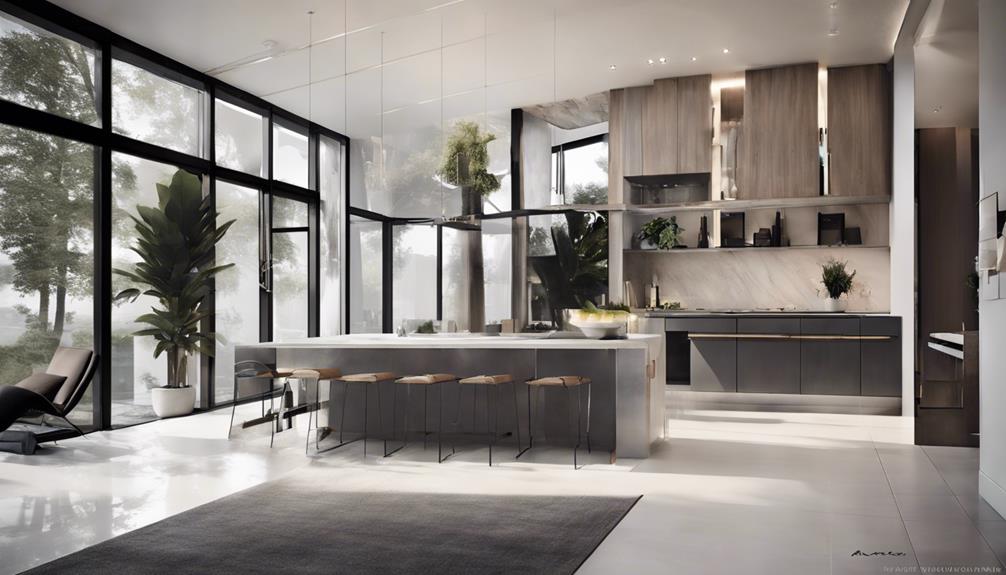
As we explore the constantly changing world of architecture, the challenge of determining what qualifies as ultra modern design in today’s buildings becomes more and more fascinating.
From the sleek facades that dominate city skylines to the incorporation of cutting-edge technologies, one cannot help but wonder how these elements converge to shape the future of architectural aesthetics.
Join us as we explore the intricate blend of innovation, sustainability, and functionality that characterizes this bold and visionary approach to design, offering a glimpse into the essence of ultra modern architecture in our contemporary world.
Key Takeaways
- Ultra modern design features sleek lines and open layouts for simplicity and fluidity.
- Integration of innovative materials and technologies like smart glass and self-healing concrete.
- Emphasis on sustainability through green features and LEED certification for eco-friendly structures.
- Future of architecture focuses on cutting-edge designs, smart technologies, and sustainable practices.
Evolution of Ultra Modern Architecture
From the late 20th century onwards, Ultra Modern Architecture has emerged as a revolutionary design movement, characterized by its cutting-edge approach and innovative use of materials. Modern architecture shifted towards contemporary practices, embracing steel, concrete, and glass as primary components to create sustainable structures that embody minimalism and functionality. The integration of innovative materials like these paved the way for unprecedented designs that pushed the boundaries of traditional architecture. Technological advancements played a crucial role in shaping this evolution, allowing architects to explore new possibilities and create structures that were once deemed impossible.
As globalization and environmental concerns gained prominence, Ultra Modern Architecture responded by showcasing unique and striking designs that not only captivated the eye but also promoted sustainability. Structures like the Guggenheim Museum Bilbao, The Shard in London, and the Burj Khalifa in Dubai stand as testaments to the avant-garde nature of this architectural style. While criticisms regarding contextual integration and costs persist, the future of Ultra Modern Architecture seems poised to embrace sustainable practices and smart technology integration, further advancing the movement towards liberation through design innovation.
Characteristics of Ultra Modern Design

Incorporating cutting-edge design elements and innovative materials like steel, concrete, and glass, ultra modern design in architecture exemplifies a fusion of minimalism, functionality, and technological integration. This contemporary approach to architecture redefines living spaces by embracing the following characteristics: clean lines, open floor plans, and seamless indoor-outdoor transitions that maximize natural light and create a sense of connection with the environment. By combining traditional and modern architecture, this style often respects historical contexts while infusing them with forward-thinking aesthetics and cutting-edge technology. The result is a harmonious blend of timeless charm and contemporary sophistication, perfectly suited for today’s dynamic lifestyles.
- Sleek Lines: Ultra modern design features clean, straight lines that create a sense of order and simplicity within a space.
- Open Concept: Spaces are often designed with an open layout, promoting a sense of freedom and fluidity throughout the living environment.
- Natural Light: Utilization of expansive windows and skylights allows for an abundance of natural light to illuminate the interior, creating a bright and airy atmosphere.
- Integration of Nature: Incorporating elements of nature like indoor gardens or green walls blurs the boundaries between indoor and outdoor spaces, fostering a harmonious connection with the environment.
- Smart Technology: Cutting-edge technologies are seamlessly integrated into the design, enhancing convenience, efficiency, and sustainability within the living space.
These characteristics collectively define the essence of ultra modern architecture, offering a liberating and forward-thinking approach to contemporary living.
Innovative Materials and Technologies
Utilizing cutting-edge materials and technologies, ultra modern architecture pushes the boundaries of innovation and sustainability in contemporary design. In ultra modern design, architects leverage modern materials like carbon fiber, titanium, and ETFE to create lightweight yet durable structures that redefine the possibilities in architecture. These materials not only offer strength and flexibility but also contribute to the aesthetic appeal of buildings. Advanced technologies such as 3D printing, parametric modeling, and smart glass are seamlessly integrated to enhance design flexibility and improve energy efficiency in ultra modern buildings.
To provide longevity and sustainability, self-healing concrete and nanotechnology coatings are employed to address maintenance and weathering challenges effectively. Furthermore, the incorporation of transparent solar panels and kinetic facades not only generates renewable energy but also enhances the visual impact of structures. The use of these innovative materials and technologies underscores the commitment of ultra modern architecture to create sustainable, efficient, and visually striking buildings.
| Modern Materials | Advanced Technologies |
|---|---|
| Carbon fiber | 3D printing |
| Titanium | Parametric modeling |
| ETFE | Smart glass |
Sustainability in Modern Architecture

Sustainable modern architecture prioritizes minimizing environmental impact through energy-efficient design and the utilization of eco-friendly materials. By incorporating green roofs, solar panels, and passive heating and cooling systems, modern buildings can significantly enhance their sustainability. Pursuing LEED certification showcases the commitment of architects to creating environmentally friendly structures. This approach aims to establish a harmonious balance between human habitation and the natural environment, fostering long-term ecological health. Not only does the integration of sustainable practices benefit the environment, but it also leads to the creation of healthier and more efficient living spaces for occupants.
- Green roofs symbolize a connection with nature and provide insulation, reducing energy consumption.
- Energy-efficient design reduces carbon footprint and promotes a greener future.
- Eco-friendly materials lessen the impact on the environment during construction and throughout the building's life cycle.
- LEED certification acts as a badge of honor, recognizing dedication to sustainable architecture.
- The use of sustainable practices in modern architecture represents a commitment to a more eco-conscious and responsible way of building for the future.
Shaping the Future of Built Environment
Shaping the future of the built environment involves a dynamic integration of cutting-edge design elements, technological advancements, and forward-thinking sustainability practices. In the realm of house design and contemporary architecture, the characteristics of modern homes are evolving to embrace open floor plans, seamless indoor-outdoor transitions, and innovative use of space. Architects are redefining the traditional notions of living spaces by incorporating more flexibility and adaptability into modern homes. This shift towards open, fluid environments reflects a desire for interconnectedness and freedom within living spaces.
Furthermore, the future of the built environment will likely see an increased focus on smart home technologies, energy-efficient solutions, and the utilization of sustainable materials. The integration of artificial intelligence and automation will revolutionize how homes function, making them more responsive to the needs and preferences of the inhabitants. As we continue to push the boundaries of design and construction, the future of modern architecture holds exciting possibilities for creating spaces that aren't only aesthetically pleasing but also highly functional and sustainable.
Frequently Asked Questions
What Defines Modernism Architecture?
Modernism in architecture is defined by a departure from traditional styles, embracing new materials and techniques for functionality and simplicity. Architects like Le Corbusier and Frank Lloyd Wright promoted clean lines, open spaces, and the integration of technology into design.
Modernist principles prioritize the essence of a structure over unnecessary ornamentation, focusing on efficiency and purpose. This movement revolutionized architectural norms, shaping the way we perceive and interact with our built environments.
What Is Modern Architecture Today?
Today, modern architecture embodies sustainability, advanced technology, and minimalism. It reflects global influences and futuristic concepts, employing materials like steel and glass for a sleek aesthetic.
Our designs prioritize functionality alongside beauty, incorporating eco-friendly features. By embracing innovation and simplicity, modern architecture today challenges traditional norms and pushes boundaries to create spaces that are both visually striking and environmentally conscious.
What Is the Concept of Modern Architecture Design?
When we explore the concept of modern architecture design, we delve into a realm where functionality meets innovation.
It's about embracing clean lines, asymmetrical shapes, and the clever integration of natural light.
Modern architecture embodies a marriage of form and function, with a nod to minimalism and the use of cutting-edge materials like steel, concrete, and glass.
This approach paves the way for structures that stand as timeless testaments to human creativity and vision.
What Are the 3 Characteristics of Modern Contemporary Architecture?
When thinking about the 3 characteristics of modern contemporary architecture, we see a focus on clean lines, innovative materials, and integration of technology. These elements create spaces that are both visually appealing and functional.
Utilizing steel, glass, and concrete, modern architecture emphasizes minimalism and sustainability. Open floor plans, natural light, and seamless indoor-outdoor transitions further define this style.
This approach allows for customization to suit individual preferences and lifestyles.
Conclusion
In conclusion, ultra modern design in today's architecture pushes boundaries, breaks conventions, and paves the way for the future of built environments.
It's like a breath of fresh air in a world saturated with traditional structures, leading the charge towards innovation and sustainability.
Embracing cutting-edge materials, technology, and a minimalist approach, ultra modern design sets a new standard for architectural excellence.
The sky's the limit for this bold and forward-thinking style, shaping the landscape of tomorrow.
- About the Author
- Latest Posts
Introducing Ron, the home decor aficionado at ByRetreat, whose passion for creating beautiful and inviting spaces is at the heart of his work. With his deep knowledge of home decor and his innate sense of style, Ron brings a wealth of expertise and a keen eye for detail to the ByRetreat team.
Ron’s love for home decor goes beyond aesthetics; he understands that our surroundings play a significant role in our overall well-being and productivity. With this in mind, Ron is dedicated to transforming remote workspaces into havens of comfort, functionality, and beauty.
-

 Decor1 week ago
Decor1 week agoMaximalist Decor Explained: Embrace More Style
-

 Vetted2 weeks ago
Vetted2 weeks ago15 Best Foot Massagers for Neuropathy to Soothe Your Feet and Relieve Discomfort
-

 Vetted3 weeks ago
Vetted3 weeks ago15 Best Sports Laundry Detergents for Keeping Your Activewear Fresh and Clean
-

 Vetted3 weeks ago
Vetted3 weeks ago15 Best Tall Toilets for Seniors That Combine Comfort and Safety
-

 Vetted4 weeks ago
Vetted4 weeks ago15 Best Dish Scrubbers to Keep Your Kitchen Sparkling Clean
-

 Vetted1 day ago
Vetted1 day ago15 Best Cleaners for Fiberglass Showers to Keep Your Bathroom Sparkling Clean
-

 Decor4 weeks ago
Decor4 weeks agoWhat Is Eclectic Home Decor
-

 Vetted6 days ago
Vetted6 days ago15 Best Organic Pest Control Solutions for a Naturally Pest-Free Home




